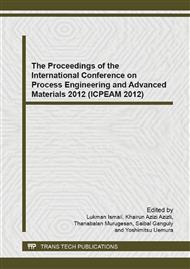[1]
Aresta, M., Carbon Dioxide Recovery and utilization. 1 ed. 2003, Norwell, MA Springer.
Google Scholar
[2]
Rousseau, R.W., Handbook of Separation Process Technology. 1987: John Wiley & Sons.
Google Scholar
[3]
Binay, K.D., Principles of Mass Transfer and Separation Processes. 2007: Prentice-Hall of India.
Google Scholar
[4]
Coulson, J.M. and J.F.B. Richardson, J.R. , Coulson & Richardson's Chemical Engineering: Fluid Flow, Heat Transfer and Mass Transfer. 2000: Butterworth-Heinemann.
Google Scholar
[5]
Danckwerts, P.V., Gas-liquid reactions. 1970: McGraw-Hill Book Co.
Google Scholar
[6]
O'Connell, J.P. and J.M. Prausnitz, Thermodynamics of Gas Solubility in Mixed Solvents. Industrial & Engineering Chemistry Fundamentals, 1964. 3(4): pp.347-351.
DOI: 10.1021/i160012a012
Google Scholar
[7]
Miller, W.J. and E. Grunwald, Self-Interaction Coefficients and Henry's Law Constants for Benzyl Chloride in a Variety of Solvents. Extrathermodynamic Prediction of Self-Interaction Coefficients1a. The Journal of Physical Chemistry, 1964. 68(6): pp.1285-1291.
DOI: 10.1021/j100788a004
Google Scholar
[8]
Jackson, S.L., Extension of Wohl's ternary asymmetric solution model to four and n components. American Mineralogist, 1989. 74: pp.14-17.
Google Scholar
[9]
Stumm, F., A. Heintz, and R.N. and Lichtenthaler, Experimental data and modeling of vapor-liquid equilibria of the ternary system carbon dioxide + water + methylamine at 313, 333 and 353 K and pressures up to 0. 4 MPa. Fluid Phase Equilibria, 1993. 91(2): pp.331-348.
DOI: 10.1016/0378-3812(93)85108-x
Google Scholar
[10]
Peng, D. -Y., Extending the Van Laar Model to MultmethylamineSystems. The Open Thermodynamics Journal, 2010. 4: pp.129-140.
Google Scholar
[11]
Kohl L, N.B., Gas Purification Handbook. 5 ed. 1997, Auston Texas Gulf Publishing Company.
Google Scholar
[12]
AspenTech, Physical Properties Data Reference Manual. Aspen Plus Chemical Process Simulation. 1997, California, USA: Élan Computer Group, Inc.
Google Scholar
[13]
Hilliard, M., Thermodynamics of Aqueous Piperazine/Potassium Carbonate/Carbon Dioxide Characterized by the Electrolyte NRTL Model within Aspen Plus ® 2004, University of Texas: Austin.
DOI: 10.2172/838130
Google Scholar
[14]
Jou, F. -Y., F.D. Otto, and A.E. Mather, Vapor-Liquid Equilibrium of Carbon Dioxide in Aqueous Mixtures of Monoethanolamine and Methyldiethanolamine. Industrial & Engineering Chemistry Research, 1994. 33(8): p.2002-(2005).
DOI: 10.1021/ie00032a016
Google Scholar


